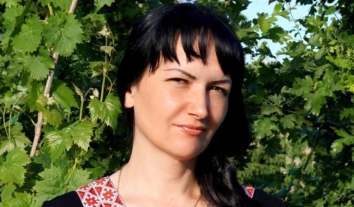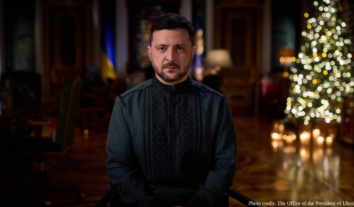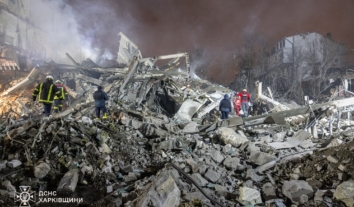A Crimean Carol: Journey Home for the Holidays
Every time I would go back to my native Crimea, I eagerly waited to see the salt-grizzled Syvash1 out of the train window. This year, though, I had to contend with nearly four kilometers of the Syvash Isthmus2 on foot with a heavy suitcase.
Just before the winter holidays, on December 26, 20143, Ukrzaliznytsia4 announced the temporary suspension of rail traffic with the occupied peninsula “for the safety and lives of passengers.” Therefore, the trains were going not to Simferopol, but only up to Novoalekseevka, a small station in the Kherson region.
I am a fourth generation Crimean: it is to the Crimean steppe that my great-grandfather moved his large family from the black-soiled Poltavshchina5 after the end of World War II. Then in the 1960s, my mother was “distributed”6 to the sunny peninsula after graduating from university in Lviv, and here she met my father. For over 40 years, he cultivated this salty, clayish ground, built a house, planted a garden, raised me and my sister. But for several years now, I have hurried home in winter not so much to the New Year’s table, as much as to bring Christmas kutia7 to his grave.
This year, to get home, I had to endure 230km of horror! This is in spite of the fact that I arrived in Novoalekseevka on December 30th, when the hype, confusion and helplessness of the early days already abated. So at the railway station, passengers fell into tight embrace of taxi drivers and others ready to transport passengers. Half an hour and you’re at the Chongar border crossing, or, more precisely, standing on the highway right in the middle of the field. No wonder that in the Nogai dialects of the Crimean grasslands, “chongar” means flat steppe.
But there was a line. As it turned out, an hour before our train from Lviv arrived, another one came in from Kyiv. Fortunately, there were freight trucks docked along the road for a few kilometers that gave us a little protection from the wind. There was also a gas station nearby that we ran to in turns to use the bathroom (for free!), while at the same time warming up and drinking tea or coffee.
From the outside, the line looked like a column of refugees: trying to avoid the wind and huddled together like penguins, carrying suitcases and gigantic bags, people were standing, covering small children. Although the temperature was a bearable -5°C, gusty wind penetrated to the bone and down jacket and sweaters didn’t protect from it. Feet were rapidly becoming colder. It seemed as if the cold was slowly rising, turning you into an icicle. This arctic pain made me want to cry. First they were letting in ten people at a time, until people began to demand to speed up the procedure. Then, the Ukrainian border guards began to let 20-25 people past the red line at a time. Russians could still only go in tens.
Finally, after having stood for almost 4 hours, I stepped over the red line. Our passports were taken and we again waited 15-20 minutes for documents to be checked. Finally, a pleasant-looking border guard allowed us to cross the border and walk to the Russian checkpoint. I curiously inquired about the distance.
“Three and a half kilometers,” he said.
At first we all rushed forward together, but after 200-300 meters it already became unbearable to walk. None of the occasional cars would stop. I dragged the suitcase and myself for about a kilometer until a man finally came with a bus. Another seven lucky passengers and I crossed the Russian border in the cabin of his “Rafik8,” and around 4 p.m. got to Dzhankoy. I could still close my eyes and see the line of people with heavy bags walking along the road, bent over and dodging the wind. Many of them women, many retirees; I saw a woman with two small children (although they were soon allowed to move through, but a resourceful lady took advantage of the situation: she took one of the kids by the hand, as if she were a relative).
A trip to Dzhankoy cost us 70 hryvnias (it is worth noting that the carriers are more willing to take the hryvnias than rubles). Here I got lucky again (or maybe, it was God’s mercy?), because I barely walked a few steps before a taxi driver emerged:
“To Chongar?”
“No, I was just there, trying to get to Kerch”
He says “A bus just left with one seat available.” And with these words he rushes after the bus, and before I know it, I am sitting in a bus going HOME!!! “Only” for 500 rubles (about 160 hryvnias, which is 60 more than in summer).
Going back was the same seven circles of hell: taxis, lines, nerves, cold. But now you worry not to miss your train. It’s a lie that the Crimean authorities organized the transportation: taxi drivers took advantage of the situation by snatching money to make up for a failed 2014 season. Their pitch is simple: no money – go on foot (it’s about 90 km to Dzhankoy and 150 to Simferopol).
Something else is not clear: why was it that passengers’ belongings used to be thoroughly checked during the border crossing by train, but not now? Why not check the arriving passengers while still in the train cars so that people could take taxis or busses to the Russian border from the train station in Novoalekseevka? After all, it would expedite the process. Besides, where is the guarantee that no “joker” at the border will throw explosives into the crowd? What’s the point of these “innovations” nine months into the seizure of the sunny peninsula?
I came back to Ternopil feeling as if I visited the front lines: the military with their weapons and you’re sadly shuffling in the line. Why is our government harassing Crimean Ukrainians? After all, it is ethnic Ukrainians, not Tatars, and especially not Russians, who are going to the peninsula and back! Does my 80-year-old mother have to come out with a rolling pin against the “spotted9” mercenaries?
Zhanna Popovich for the Human Rights Information Center
Crimea – Ternopil
[1] A bay to the west of the Sea of Azov that separates the Crimean Peninsula from the mainland of Ukraine
[2] A man-made isthmus parallel to the Isthmus of Perekop, which connect the Crimean Peninsula to the mainland of Ukraine, specifically the Kherson region
[3] As the Orthodox Christmas is celebrated on January 7th, the winter holidays in Ukraine traditionally begin with the New Year
[4] Ukrainian Railways
[5] Collective name of historical and ethnographic region in central Ukraine with center in Poltava
[6] A Soviet practice of obligatory job placement upon university graduation
[7] A sweet grain pudding traditionally made on Christmas Eve or as a ritual dish of remembrance in the Eastern Orthodox tradition
[8] RAF-2203 minibus
[9] Russian soldiers have distinctive spotted camouflage










